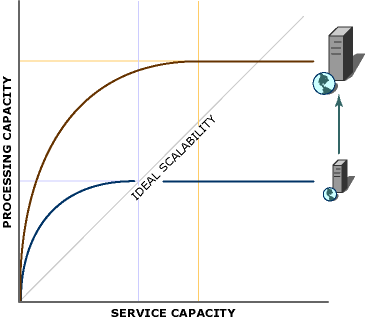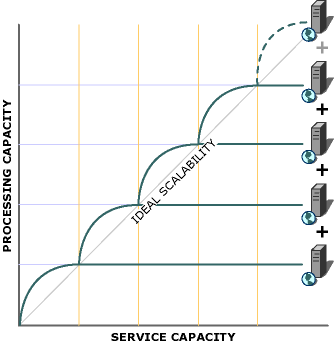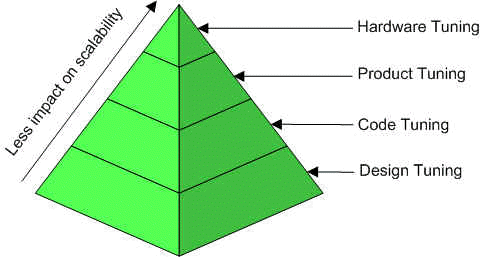Scalability
Summary
The key characteristic of a scalable application is that additional load only
requires additional resources rather than extensive modification of the
application itself. Therefore, scalability is the ability to add resources to
yield a linear increase in service capacity.
Scalability must be part of the design process because it is not a feature
that can be added later or during deployment. The decisions that you take during
the design phase and early coding phases will largely dictate the scalability of
your application. However, note that salability is not a design concern of
stand-alone application, but rather it concerns distributed applications.
Distributed applications are a step beyond client-server applications because
distributed applications are designed as n-tier applications. Such distributed
architecture promotes the design of scalable application by sharing resources
such as business and database components.
Scalability requires a balancing act between software and hardware. For
example, building a network-load-balanced cluster of application servers will
not benefit a client application if server-side code was written to run on a
single server (see location affinity rather then location transparency.)
Likewise, writing a highly scalable application and then connecting it to a low
bandwidth network will not handle heavy loads when traffic saturates the
network.
Scaling Up
Scaling up means achieving scalability by using bigger and faster hardware.
Bigger and faster hardware means adding more memory, adding more processors,
replacing old processors with faster one. Scaling up typically allows for an
application to increases its capacity without having to change code.
Administratively, things also remain the same as there is still one machine to
administer. Scaling up is summarized below:

Note that scaling up does no increase capacity linearly. Instead, the
performance gain curve slowly reaches its limit as more resources are added. For
example, adding four processors to server does it not increase capacity to 400%
over the unprocessed version. Synchronization between these processors as well
as contention over a single memory-bus will result in a lower performance gain.
Once you have upgraded each hardware component to its maximum limit, you will eventually
reach the real limit of the machine's processing capacity. At that point, the
next step in scaling up is to move to a bigger and faster machine.
Scaling up also presents another potential problem. Using a single machine to
support an application creates a single point of failure, and this greatly
diminishes the system-availability.
Scaling Out
Scaling out is an alternative to scaling up. Scaling out is about
distributing the processing load over multiple machines. Although scaling out is
achieved using multiple machines, these machines will essentially share load and
function as a single server. Scaling out is summarized below

Also note that by dedicating several machines to a common task, application
fault tolerance is increased. However, from an administrator's point of view,
scaling out presents greater management challenges due to the increased number
of servers.
Obviously, configuring multiple servers to share load from clients requires
special software. With Windows, you can use a variety of techniques including
clustering and load-balancing. Load-balancing allows a collection of servers to
scale out across a cluster of servers. Load-balancing also provides redundancy
allowing the collection of servers to remain available to users even if one or
more servers fail.
The key to successful scaling out is location transparency (as opposed to
location affinity) - if any of the application code depends on knowing what
server is running the code, location transparency has not been achieved and
scaling out will be difficult. This situation is called location affinity. If
you design an application with location transparency in mind, then scaling out
becomes an easier task.
Primary Design Goal: efficient resource management. Contention for
resources is the root cause of all scalability problems.
It is design phase decisions that have the greatest impact on scalability. As
the figure below shows, good design is literally the foundation for a highly-scalable
application:

As the scalability pyramid indicates, hardware, software and code tuning are
only a small part of the scalability solution. Design, which is at the base of
the pyramid, has the greatest influence on scalability. The ability to impact
scalability is decreased as you move up the scalability pyramid. Smart design
can add much more to an application's scalability than hardware.
Because the primary design goal for scalability is efficient resource
management, design is not limited to a specific component or tier of an
application. As a designer, you must consider scalability at all levels - from
the data store to the user interface. The following recommendations can be
helpful when designing for scalability.
- Do Not Wait
Synchronous methods are usually methods that need to wait to return a
result before continuing, or that need to verify that an action was
successful before continuing. That is, all actions associated with the
operation must fail or succeed before continuing with the operation.
Applications designed to use synchronous methods can negatively affect
scalability due to possible contention over resources. Other methods must
wait if a resource is already used by another method.
If a process/method is holding
on to a resource, then another process/method cannot access that resource.
A process/method should not wait longer than is necessary. To
alleviate this situation, use asynchronous processing. When operating
asynchronously, long-running operations are queued for completion later
by a separate thread.
For example, e-commerce sites need to perform credit card validation during
the checkout phase. In a high-volume site, credit card validation can become
a bottleneck if there is a difficulty in the validation process. This
process is a typical candidate for asynchronous processing - a separate
thread can send the credit card validation result (once available) back to
the client, while allowing other clients to proceed with their credit card
validation process.
- Do Not Fight For Resources
Because contention for resources is the root cause of all scalability
problems, it should be noted that insufficient memory, processor cycles,
network bandwidth or database connections will all lead to an application
that does not scale.
Regardless of design, all distributed applications possess a finite
amount of resources. Besides using asynchronous processing to release
resources as soon as possible, other steps can be used to avoid resource
contention. For example, scarce resources should only be acquired if necessary,
and if so, should be acquires as later as possible and released as early as
possible. For example, return database connections to the pool as soon as
possible, or if a transaction needs to lock data, then either lock a
specific row or lock the table for the shortest possible time.
- Design for Commutability
This is one of the most overlooked ways to reduce resource contention.
Two or more methods are called commutative if they can be applied in any
order and still obtain the same result. Operations that can perform in the absence
of transactions are likely candidates.
For example, a product promotion procedure might involve reducing its
price by 10% and then adding it to the list of products already in the
[Promotions] table. This procedure is commutative because it does not matter
whether your reduce price first, or added it to the [Promotions] table.
Scalability can be affected here by performing all such product promotions
on temporary tables and then updating the relevant permanent tables with the
net change in one transaction.
- Design for Interchangeability
General resources can be interchangeable. For example, if a database
connection is unique to a user, it cannot be pooled for use by other users.
In contrast, database connections that use a common-ser of credential can be
used by all users accessing the connection pool.
The concept of interchangeability supports the concept of moving state
out of your components. Requiring components to maintain state in between
method calls defeats interchangeability and ultimately scalability. Instead,
make each method call self-contained. Store state outside methods when it is
needed across method calls. A good place to keep state is the database. When
calling a method of a stateless component, any state required by that method
can either be passed in as a parameter or read from the database. At the end
of the call, preserve any state by passing it back to the method caller or storing
it in the database.
- Partition Resources and Activities
By minimizing relationships between resources and between activities,
you minimize the risk of creating bottlenecks resulting from one member of
the relationship taking longer than the other. Two resources that depend on
one another will live and die together.
Scalability testing is an extension of performance testing. Scalability
testing is about identifying major workloads and resolving bottlenecks that can
impede the application's scalability. As an application is scaled up and/or out,
comparison of performance test results against a baseline performance test
will indicate whether the application scales or not.
The following best practices are recommended for creating scalable
application.
- Follow Designing for Scalability
recommendation
- Use Clustering Technologies
Clustering services include network load balancing, clustering service, and
component load balancing (CLB). Network Load Balancing (NLB) acts as a
front-end cluster that distributes incoming IP traffic across a cluster of
up to 32 servers. NLB is an excellent technique for increasing scalability
and availability. Clustering service acts as a back-end cluster and provide
high-availability for applications such as database, messaging, and file
servers. CLB distributes workload across multiple servers running the site's
business logic.
- Consider Logical versus Physical Tiers
Logical separation should always be considered when designing distributed
application. The application should be logically partitioned across the user
interface layer, business logic layer, and data access layer. Logical
separation does not mandate physical separation but makes it possible.
Logically partitioning an application enables physical separation of layers,
which in turn leads to better scalability by scaling out the application
across different machines.
- Isolate Transactional Methods
Separate transactional methods from non-transactional methods. Placing
non-transactional methods in a component that requires transactions for its transactional
methods will negatively affect scalability because this component will
always incur the cost of a transaction even if the transaction was not
required.
- Eliminate Business Layer State When Possible
You can increase the scalability of a server-side layer by making it as
stateless as possible. A component in a server-side layer that must maintain
state between calls consumes resources. For example, a CAO (Client-Activated
Object) in .NET Remoting remains alive in between calls and as such can
maintain state until it is destroyed by the client. While the CAO is alive
it is consuming a thread-pool thread affecting the scalability of the .NET
Remoting thread pool. On the hand, an SAO (Server-Activated Object) in the
form of a Single Call object, is destroyed after call. After the SAO is
destroyed, it releases any resources it was holding including the
thread-pool thread.
- Review Best
Practices for Performance



